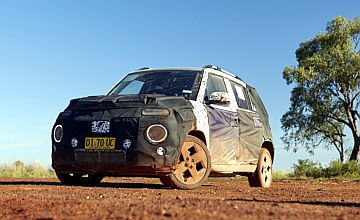2025 Hyundai Inster Prototype Drive

BODANGORA might not be a name you know, unless you’re from the central west of New South Wales.
This tiny locality plays host to a few houses, not many people, and an isolated airstrip – which is where we got to drive the new Hyundai Inster.
Well, kind of... The vehicle we drove was actually a hand-built prototype decked out with the camouflage coverings you’d expect both inside and out; and, as I was told by the Hyundai Australia team, it was “not representative of what the final product will be like”.
The car we got to drive – one of two here for global hot weather testing ahead of its introduction to our market in early 2025 – was left-hand drive, and I was told it weighed about 1350kg.
So, despite its tiny size, it’s a bit hefty.
In fact, size is an important consideration. The Inster, which is based on the petrol-powered Casper model sold in South Korea, is the smallest model in the range, spanning 3825mm on a 2580mm wheelbase, with a width of 1610mm and a boxy body giving it a height of 1575mm.
So, why Bodangora?
It’s in the middle of nowhere, firstly. It’s also a hot location – literally, the mercury regularly passes 45 degrees Celsius in these parts, and the Inster was in Australia for hot weather testing.
On a Sunday in January it was a rather mild 37 degrees.
And while I wasn’t expecting to learn too much about the car by driving it up and down Bodangora airstrip a few times, there were some things that impressed me.
The test mule had multiple drive modes, and while it wasn’t clear that all the modes were tuned to their final settings, there was a difference in zippiness from a standstill and during roll-on acceleration.
The claimed 0-100km/h time is 11.7 seconds for the Standard Range and 10.6 seconds for the Long Range – and while I didn’t have anything to measure that number, it seems pretty honest.
But really, it’s the 0-50km/h acceleration that might be more pertinent as that’s what this will be doing more often in city streets and suburbia, but it felt nippy and fast enough.
As with the Kona EV and other Hyundai products, the Inster I tested also had multiple regen braking modes.
You can essentially tailor the behaviour of the brakes, including a ‘single pedal’ mode, which was assertive enough – and you can use the paddle shifters to adjust those modes, and even hold down the left paddle and the car will come to a complete stop – just like other Hyundai models.
Hyundai Australia said that Inster models sold here will feature a locally developed ride and handling tune, but the test car didn’t have that yet.
And look, a smooth, straight line isn’t the ideal location to test the steering and ride anyway, but it seemed to feel decently planted and predictable enough in terms of the steering response.
While this was hardly an exhaustive test, it is clear that this is an important model for Hyundai – provided that the brand gets the pricing and specs right…